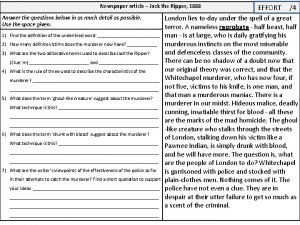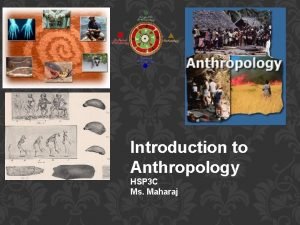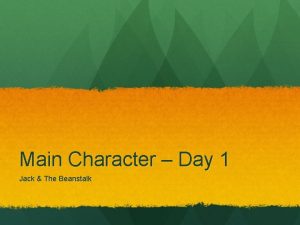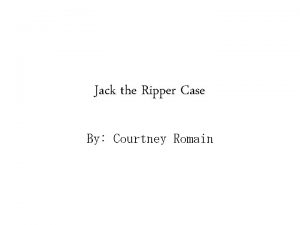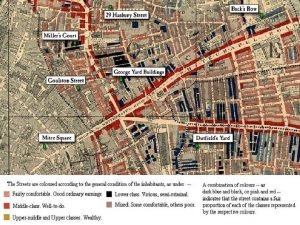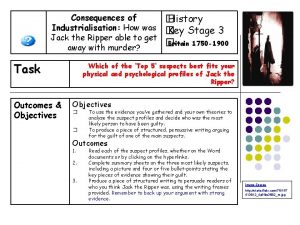Jack the Ripper Case Study HSP 3 UI



















- Slides: 19

Jack the Ripper Case Study { HSP 3 UI Chard

Rationale Jack the Ripper was modern Western civilization’s first serial killer. If theory in this movie is correct, he is not a typical serial killer. If this theory is not correct, he is. Either way we can use this movie as a bridge to further understanding why serial killers exist in our society, and what we can do to diminish them. We will also practice our profiling skills with the assignment that accompanies the movie. The Film: “From Hell”

the murders of the 5 prostitutes, their names, the positions the bodies were found in and the specific mutilations done to them the prostitutes were all intoxicated when killed the investigators (Inspector Abberline) the members of the Freemasons and the structure of the organization at the time the letters from the Ripper (signed “From Hell, ” and one sent with a kidney from one of the victims) the social conditions of Whitechapel (East London) in 1888 (poverty, prostitution, alcoholism, violence, etc. ) Historical Truth in the Film (facts)

the profile of Jack the Ripper presented throughout Queen Victoria’s grandson Albert stayed at painter’s Walter Sickert’s flat “undercover” and probably at least met Anne Crook (and maybe more…) religious overtones (Protestant v. s. Catholic) the “Elephant Man” John Merrick the level of anti-semitism in Europe at this time the message written on the wall of the apartment after one of the murders (“The Juwes are the men That Will be blamed for nothing” Police Commissioner Sir Charles Warren ordered the message to be erased before sunrise, destroying its value as evidence (the reason he gave was fear of riots against London’s Jewish minority- but did this message refer to the Jewish religion, or something else ? . . . )

a leather apron was found after one murder only one witness actually saw and described the Ripper the police “stood down” after the 5 th murder, meaning they must have thought the Ripper was out of commission (in jail, a mental institution or dead)

Inspector Abberline’s visions and opium addiction the Ripper’s identity the Abberline/ Mary Kelly storyline the prostitutes knew each other Interpretations/Theories/ Dramatization in the Movie (opinion)

1. Using your knowledge of profiling from Unit 1 and Serial Killers from this unit, create a profile of the “Jack the Ripper” suspect based on the facts of the case using the following categories and give a reason for each speculation: Gender Occupation Lifestyle Motivation Category (your choice) Age Education Personality Type One Other Analyze theory regarding the Ripper’s identity and motivations presented in the movie. Is it feasible ? Why or why not ? Describe the social conditions in Whitechapel (East London) with examples from the film. Has modern Western society changed in this regard ? Explain. Prostitutes are the main victims of serial killers. Why do you think this is the case ? Give at least two reasons. The Assignment

go through original slides again Debriefing

if this is true, Jack the Ripper is not a typical serial killer Theory presented in the Film

The Duke of Clarence marries and fathers a child with Annie Crook, a shop worker from the East End of London; she is unaware of her husband's royal position. Queen Victoria becomes aware of the marriage, and has Albert separated forcibly from his wife, whom she then places in an asylum. Victoria then instructs her royal physician Sir William Withey Gull to impair Annie's sanity, which he does by damaging or impairing her thyroid gland (Gull was the first to describe the state of hypothyroidism, calling it a 'cretinoid condition in adult women'. ) The potentially scandalous matter is resolved, until a group of prostitutes - Annie's friends - who are aware of the illegitimate child and its royal connections, attempt blackmail in order to pay off a gang of thugs who are threatening them. Gull is once again enlisted, this time to silence the group of women who are threatening the crown. The police are complicit in the crimes - they are granted prior knowledge of Gull's intentions, and are adjured not to interfere until the plot is completed.

Gull, a high-ranking Freemason, begins a campaign of violence against the five women, brutally murdering them with the aid of a carriage driver called John Netley. While he justifies the brutal murders by claiming they are a Masonic warning to an apparent Illuminati threat to the throne - the Illuminati were blamed, in some quarters, for the French Revolution - the killings are in actuality part of an elaborate mystical ritual to mirror the executions of Jubela, Jubelo and Jubelum for killing Master Mason Hiram Abiff (throats cut from left to right, mutilation, etc. ) It is revealed that Gull suffered a stroke a year previous to his killings in the East End; during this episode he was afforded a vision of Jah-Bul-On, a masonic deity. Apparently, it was this vision that prompted the later murders, and its accompanying masonic designs.

Gull takes John Netley, his coachman, sole confidant, and reluctant aide, on a tour of London landmarks (including Cleopatra's Needle and Nicholas Hawksmoor's churches), expounding about their hidden mystical significance, which is lost to the modern world. Later, Gull forces the semi-literate Netley to write the infamous "From Hell letter" which lends the work its title. Gull has a number of transcendent, mystical experiences in the course of the murders, culminating with a vivid vision of what London will be like a century after he apparently kills Mary Jane Kelly. Unknown to Gull, the Mary Kelly he has killed is actually another woman who was sleeping in her lodgings. Nevertheless this oversight does not impede the magical aspect of Gull's plan, and it is implied that, through his grisly activities, male dominance over femininity is assured, and the twentieth century is thus given its dominant form Gull is tried by a secret Freemasonic council, which determines he is insane; Gull, for his own part, refuses to submit to the council, informing them that no man amongst them may be counted as his peer, and may not therefore judge the 'mighty work' he has wrought. A phony funeral is staged, and Gull is imprisoned under a pseudonym 'Thomas Mason'.

if any of these three main suspects did it, Jack the Ripper is a typical serial killer The Other Suspects

A member of London's Polish-Jewish population, Aaron Kosminski was born in Kłodawa, Poland, in 1865. He was transferred to “Colney Hatch Lunatic Asylum” in February 1891, but let out after a number of years. . He was named as a suspect in Chief Constable Melville Macnaghten's memoranda, which stated that there were strong reasons for suspecting him, that he "had a great hatred of women, with strong homicidal tendencies", and that he strongly resembled "the man seen by a City PC" near Mitre Square. He was committed to another institution around the time of the last Ripper murder. Aaron Kosminski

Seemingly uneducated or self-educated American, he earned a small fortune posing as an expert doctor throughout the USA and Canada and occasionally traveling across Europe as well. Perceived as a misogynist, he was connected to the deaths of some of his patients, though it is uncertain if this was deliberate or not. Francis was in England in 1888. He was arrested on November 7, 1888, "on charges of gross indecency", apparently for engaging in homosexual practices, then released on bail. Francis Tumblety

He “collected” wombs in jars. Tumblety was mentioned as having been a Ripper suspect by a member of the Metropolitan Police in a letter to a journalist many years after the murders, but this official was not known to have been directly connected to the Ripper investigation.

The son of a prominent local physician. Having received his B. A. from the University of Oxford in 1880, he was admitted to the bar in 1885. His body was found floating in the River Thames at Chiswick on December 31, 1888. Medical examination suggested that his body was kept at the bottom of the river for several weeks by stones placed in his pockets. The coroner's jury concluded that he committed suicide by drowning "whilst of unsound mind. " His mother suffered from depression and died in an asylum in 1890. His disappearance and death shortly after the fifth and last canonical murder (which took place on 9 November 1888) and alleged "private information" led some of the investigators of the time to suggest he was the Ripper, thus explaining the end to the series of murders Montague Druitt

The most likely suspect is Montague Druitt because: Druitt’s father, grandfather, brother and nephew were doctors and there was evidence he was a medical student at one time’ his mother was admitted to an “insane asylum” right before the Ripper killings started his strong resemblance to Prince Albert, the Duke of Clarence rumours he was gay and that he had a hatred of women he committed suicide right after the last murder Donald Rumbelow’s “Unofficial” View

The Prince and Druitt
 Jack the ripper newspaper
Jack the ripper newspaper Hsp
Hsp Hsp
Hsp Hsp3c
Hsp3c Hsp
Hsp Basic dermatology curriculum
Basic dermatology curriculum Hsp
Hsp [email protected]
[email protected] Jack and the beanstalk character traits
Jack and the beanstalk character traits Best case worst case average case
Best case worst case average case Project failure case study
Project failure case study Ripper titration
Ripper titration Pinking shears target
Pinking shears target The ripper
The ripper Hình ảnh bộ gõ cơ thể búng tay
Hình ảnh bộ gõ cơ thể búng tay Frameset trong html5
Frameset trong html5 Bổ thể
Bổ thể Tỉ lệ cơ thể trẻ em
Tỉ lệ cơ thể trẻ em Voi kéo gỗ như thế nào
Voi kéo gỗ như thế nào Glasgow thang điểm
Glasgow thang điểm
